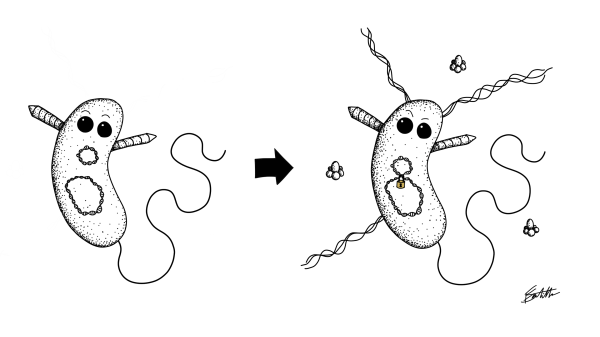
Pandemic Vibrio cholerae (right) locks down a DNA element (Aux3) that was previously mobile in harmless, environmental strains of Vibrio cholerae (left). Image credit: Francis J. Santoriello
Researchers at The City College of New York have uncovered a novel way in which Vibrio cholerae, the aquatic microbe that causes cholera, may increase its competitive fitness, and the likelihood of creating pandemic strains of the bacteria.
The finding was revealed by examining the type VI secretion system, or T6SS for short, a secretion system used by Vibrio cholerae to inject toxic proteins into neighboring bacterial cells, killing them and increasing its survival advantage. The researchers studied a gene cluster within the T6SS called auxiliary cluster 3 (Aux3). The gene cluster exists in two states: one, which is highly mobile, is found in environmental strains of V. cholerae—these do not cause disease—and a second, which is a less mobile form of the gene cluster. This second, less mobile form of the gene cluster is “locked” in the pandemic V. cholerae genome and potentially helped create the pandemic strains.
“We wanted to look at how a harmless environmental strain of Vibrio cholerae acquires the unique traits needed to become the pandemic strain of the bacteria,” said Francis J. Santoriello, from City College’s Department of Biology. “With this in mind, we located an island in the chromosome of the bacteria that only exists in the pandemic strain. Unexpectedly, we found a much larger form of the DNA island in a couple strains in the environment that seems to be jumping from one strain to another.”
Stefan Pukatzki, lead author of the CCNY study, added, “Even though we may not have a cure for cholera, this research contributes to our understanding of how these pathogens evolve and become pandemic.”
The study, “Pandemic Vibrio cholerae shuts down site-specific recombination to retain an interbacterial defense mechanism” appears in the December issue of “Nature Communications,” providing new insights into this devastating and deadly illness, which is particularly endemic in the developing world.
Both Santoriello and Pukatzki have affiliation with the University of Colorado Denver’s Department of Immunology and Microbiology.
About the City College of New York
Since 1847, The City College of New York has provided a high-quality and affordable education to generations of New Yorkers in a wide variety of disciplines. CCNY embraces its position at the forefront of social change. It is ranked #1 by the Harvard-based Opportunity Insights out of 369 selective public colleges in the United States on the overall mobility index. This measure reflects both access and outcomes, representing the likelihood that a student at CCNY can move up two or more income quintiles. In addition, the Center for World University Rankings places CCNY in the top 1.8% of universities worldwide in terms of academic excellence. Labor analytics firm Emsi puts at $1.9 billion CCNY’s annual economic impact on the regional economy (5 boroughs and 5 adjacent counties) and quantifies the “for dollar” return on investment to students, taxpayers and society. At City College, more than 16,000 students pursue undergraduate and graduate degrees in eight schools and divisions, driven by significant funded research, creativity and scholarship. CCNY is as diverse, dynamic and visionary as New York City itself. View CCNY Media Kit.
Max Dorfman/Jay Mwamba
p: 212.650.7580
e:
jmwamba@ccny.cuny.edu
View CCNY Media Kit.